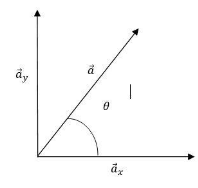
One of the Rectangular components of a vector of magnitude 50 units is 25 units. The angle it makes with this component is
(A) \[30^\circ \]
(B) \[60^\circ \]
(C) \[45^\circ \]
(D) \[37^\circ \]
Answer
527.4k+ views
Hint:Vector is defined as the physical quantity which has magnitude as well as direction.So in this question we are going to resolve a vector into two components and some mathematical calculations we can arrive at the correct result.
Complete step by step answer:
Characteristics of vectors are as follows:
1) Vectors possess magnitude as well as direction.
2) They do not obey the ordinary laws of algebra.
3) Vector changes if either magnitude or direction changes.
Any vector, $\overrightarrow a ,$can be resolved into two components. ${a_x}$is component parallel to the X-axis and ${a_y}$is component parallel to the Y-axis. Angle $\theta $gives the direction of the vector with respect to the axis.

Now, according to the question.
$\therefore \left| {\overrightarrow a } \right| = 50units$
And $\left| {\overrightarrow {{a_x}} } \right|25units$
From the figure above, we observe that, \[\cos \theta = \dfrac{{\left| {\overrightarrow {{a_x}} } \right|}}{{\left| {\overrightarrow a } \right|}}\]
By substituting the given values, we get
$ \Rightarrow \cos \theta = \dfrac{{25}}{{50}}$
$ \Rightarrow \cos \theta = \dfrac{1}{2}$
\[ \Rightarrow \theta = 60^\circ \]
Therefore, the correct answer is (B) \[60^\circ \]
Note:The concept of vector is very important. In some cases, direction matters as much as the length or distance. For example, say, you are driving a car with some acceleration. Then you apply a break and the car stops. Now, the car will not go from some velocity to zero velocity in an instant. The velocity will reduce gradually and become zero. That means, there is some acceleration which is opposite to the acceleration you were applying to drive the car. Now if we do not consider the fact that both the accelerations were in opposite directions, then we will never be able to explain why the car stopped.
Some examples of vector are, displacement, velocity, acceleration, force, Weight and moment.By Parallelogram law of vectors, the magnitude of resultant vector is given by,
$R = \sqrt {{P^2} + {Q^2} + 2PQ\cos \theta } $
And the direction is given by
$\tan \alpha = \dfrac{{Q\sin \theta }}{{P + \cos \theta }}$
Complete step by step answer:
Characteristics of vectors are as follows:
1) Vectors possess magnitude as well as direction.
2) They do not obey the ordinary laws of algebra.
3) Vector changes if either magnitude or direction changes.
Any vector, $\overrightarrow a ,$can be resolved into two components. ${a_x}$is component parallel to the X-axis and ${a_y}$is component parallel to the Y-axis. Angle $\theta $gives the direction of the vector with respect to the axis.

Now, according to the question.
$\therefore \left| {\overrightarrow a } \right| = 50units$
And $\left| {\overrightarrow {{a_x}} } \right|25units$
From the figure above, we observe that, \[\cos \theta = \dfrac{{\left| {\overrightarrow {{a_x}} } \right|}}{{\left| {\overrightarrow a } \right|}}\]
By substituting the given values, we get
$ \Rightarrow \cos \theta = \dfrac{{25}}{{50}}$
$ \Rightarrow \cos \theta = \dfrac{1}{2}$
\[ \Rightarrow \theta = 60^\circ \]
Therefore, the correct answer is (B) \[60^\circ \]
Note:The concept of vector is very important. In some cases, direction matters as much as the length or distance. For example, say, you are driving a car with some acceleration. Then you apply a break and the car stops. Now, the car will not go from some velocity to zero velocity in an instant. The velocity will reduce gradually and become zero. That means, there is some acceleration which is opposite to the acceleration you were applying to drive the car. Now if we do not consider the fact that both the accelerations were in opposite directions, then we will never be able to explain why the car stopped.
Some examples of vector are, displacement, velocity, acceleration, force, Weight and moment.By Parallelogram law of vectors, the magnitude of resultant vector is given by,
$R = \sqrt {{P^2} + {Q^2} + 2PQ\cos \theta } $
And the direction is given by
$\tan \alpha = \dfrac{{Q\sin \theta }}{{P + \cos \theta }}$
Recently Updated Pages
Physics and Measurement Mock Test 2025 – Practice Questions & Answers

NCERT Solutions For Class 5 English Marigold - The Little Bully

NCERT Solutions For Class 12 Maths Three Dimensional Geometry Exercise 11.1

NCERT Solutions For Class 11 English Woven Words (Poem) - Ajamil And The Tigers

NCERT Solutions For Class 6 Hindi Durva - Bhaaloo

NCERT Solutions For Class 12 Physics In Hindi - Wave Optics

Trending doubts
1 ton equals to A 100 kg B 1000 kg C 10 kg D 10000 class 11 physics CBSE

Difference Between Prokaryotic Cells and Eukaryotic Cells

One Metric ton is equal to kg A 10000 B 1000 C 100 class 11 physics CBSE

1 Quintal is equal to a 110 kg b 10 kg c 100kg d 1000 class 11 physics CBSE

Proton was discovered by A Thomson B Rutherford C Chadwick class 11 chemistry CBSE

Draw a diagram of nephron and explain its structur class 11 biology CBSE




